|
| |
Archives
|
Saturday September 3 2005
|
book recommendations

I read John Steinbeck's The Grapes of Wrath for the first time a couple of months ago. I was 60 years old. Please don't wait so long if you haven't read it yet. If it's been a while since you read it you might want to read it again. It's absolutely incredible. It's about the migration of tenant farmers from Oklahoma to California during the 1930s. As I read it I was struck by how it might not take much for there to be a need for a similar migration to occur in our near future. If the economy is as on a shaky foundation as many believe (including myself), we may see a modern equivalent of the 1930's migration of the dispossesed. A modern Grapes of Wrath. Then Katrina happened.
Shortly after reading The Grapes of Wrath I was sorting through some of my boxes of books and came across a book I've had for years and never got around to reading.

Dorothea Lange: American Photographs. Dorothea Lange's images are some of the finest from the Depression. She had been a portrait photographer in San Francisco and, in the early 1930s, she started noticing the victims of the Depression on the streets and started taking pictures. In 1935 she married Paul Taylor. He was an economist studying agriculture in California and became more than Lange's husband. He was her collaborator. His studies were illustrated with her pictures. This book covers that collaboration. She became part of the Farm Securities Administration (FSA) and produced some of her finest work for them. Great pictures.
In searching for more information on Dorothea Lange, I came across this book:

Dorothea Lange: The Heart and Mind of a Photographer. It was on the pricy side and was on my Amazon wish list. Then I rediscovered Daedalus Books. The list price for this book is $75 and Daedalus has it for $24.98. Get it here while they last. It covers different aspects of Dorothea Lange's life and work and has more nicely printed photographs.
There is another book that I don't have but wish I did. (It's in my Amazon wish list).
An American Exodus: A Record of Human Erosion by Dorothea Lange and Paul S. Taylor. It's a landmark book combining text and photographs. It came out in 1939 and didn't do well. Times were changing. But they had published studies and images for years and it was those studies and photographs that Steinbeck used in researching The Grapes of Wrath. It was those studies and pictures that got the federal government to set up camps for the refugees. Dorothea Lange was a social activist working for change. We are going to need more Dorothea Langes.
Dorothea Lange has also been an inspiration for me to use the Graflex SLR. She used the big Graflexes a lot. Migrant Mother was shot with a Graflex.
Reading The Grapes of Wrath and looking at Lange's pictures brings home the devastation that these people endured. And while these books on Lange have many fine images, there is a cheaper way to see them. Many of her images were done while she was working for the FSA. Since she was a government employee, her work is public domain. There are several sites with her FSA pictures. Some are high resolution suitable for printing your own Dorothea Lange photograph.
M I G R A N T W O R K E R S
Photographer: Dorothea Lange
America from the Great Depression to WWII.
Google Images for Dorothea Lange
image results for Dorothea Lange
Dorothea Lange Reproductions
katrina
First of all, check out the donation link under the navigation bar on the left. Donate.
Second, Zoe found out that Air America Radio has set up public voicemail for Katrina victims to communicate. Check out her post for more information...
PSA -- Emergency Voicemail For Victims of Katrina
This post from Laura Rozen shows how cold these bastards are.
September 03, 2005
|
If he could go to Baghdad, why didn't Bush go to the New Orleans Superdome or the Convention Center? It was bizarre for all of the country and much of the world to be watching those scenes for days on our TVs and news reports, and for Bush's photo ops to be in areas that were far less critical. I know there are security considerations but his visit seemed extraordinarily hollow even by this administration's standard of ultra-stage managed events.
Dutch viewer Frank Tiggelaar writes:
There was a striking dicrepancy between the CNN International report on the Bush visit to the New Orleans disaster zone, yesterday, and reports of the same event by German TV.
ZDF News reported that the president's visit was a completely staged event. Their crew witnessed how the open air food distribution point Bush visited in front of the cameras was torn down immediately after the president and the herd of 'news people' had left and that others which were allegedly being set up were abandoned at the same time.
The people in the area were once again left to fend for themselves, said ZDF.
| |
[more]
Bush has no intention of actually doing anything. Just put up a photo op and people will forget that nothing was actually done. I don't think it's going to work this time. This disaster is too huge. It's not going away. It will only get worse. Much worse. And don't think that race has nothing to do with this. The is racist America for all the world to see.
Superdome Evacuations Temporarily Halted
|
At one point Friday, the evacuation was interrupted briefly when school buses pulled up so some 700 guests and employees from the Hyatt Hotel could move to the head of the evacuation line — much to the amazement of those who had been crammed in the Superdome since last Sunday.
"How does this work? They (are) clean, they are dry, they get out ahead of us?" exclaimed Howard Blue, 22, who tried to get in their line. The National Guard blocked him as other guardsmen helped the well-dressed guests with their luggage.
The 700 had been trapped in the hotel, near the Superdome, but conditions were considerably cleaner, even without running water, than the unsanitary crush inside the dome. The Hyatt was severely damaged by the storm. Every pane of glass on the riverside wall was blown out.
| |
[more]
thanks to Eschaton
They are in front of the line becasue they are white. They are in front of the line because they are first class passengers and the blacks are third class passengers and, if you watched Titanic, you know how third class passengers are treated. They are locked down below and drown.
How bad is this going to be? We have several hundreds of thousands of refugees. Maybe upwards of a million? More? What in the hell do you do with all these people. The Houton Astrodome is full. There is no place for these people to go.
Refugees still waiting for relief
|
And the hurricane experts shook their heads in disgust and futility, much of it directed at the Federal Emergency Management Agency (FEMA).
"We told FEMA, and we told them long ago, and we told them more than once that they needed to purchase the land for tent cities with full facilities in anticipation of this," said Ivor van Heerden, deputy director of the Louisiana State University Hurricane Center, where experts warned since the late 1990s that New Orleans' levees couldn't withstand the storm surge of a major hurricane.
"They told me Americans don't live in tents," van Heerden said. "I guess that sums up their attitude."
[...]
"I fear the worst is yet to come," said Jennifer Leaning, a Harvard University public health professor who is helping with the Red Cross relief coordination. "No refugee population in the world lives like this. There is a vast need for at least a little personal privacy. The sanitation problems, disease, and civil unrest will grow. To think that we can house people in the open in these vast shelters like the Superdome and the Astrodome for more than a couple weeks is delusional."
| |
[more]
thanks to War and Piece
There is no planning or anything put in place to house these people. Nothing! And do you think that these people will be welcome for very long?
Some Houstonians question welcome-mat effort
Refugees being helped at expense of the city's poor is one sentiment
|
Amid the overwhelmingly compassionate response to hurricane evacuees in Houston, a less-welcoming undercurrent is developing among people worried about the impact of thousands of needy, desperate people.
| |
[more]
Ever read The Grapes of Wrath? Large refugee migrations cause huge disturbances and may be looking at something on the scale not seen since the Great Depression. And the number of refugees during the 1930s evolved over a period of years as the the farms failed. We now have an instant refugee population that rivals that of the 1930s.
And what about rebuilding New Orleans? Do you think the refugees are going to be able to afford the rebuilt housing? Federal guidelines won't allow the New Orleans we know to be rebuilt.
Hurricane Q&A
|
Federal regulations require that when a building erected in a flood plain is substantially damaged, it must be elevated when it is rebuilt. Does this mean that if New Orleans is rebuilt, the whole city will be on stilts?
Large parts of it, yes. Federal Emergency Management Agency officials say that much of New Orleans is considered a flood plain, and if structures are rebuilt in those parts of the city, they will have to be elevated substantially. "Absolutely, yes," said Ed Pasterick, a FEMA specialist in Washington, D.C. "There may be decisions to be made as to whether large areas of the city can or should be rebuilt."
Before any of New Orleans can be rebuilt, millions of gallons of toxic sludge and millions of tons of wreckage into which the toxins have been soaking will have to be removed. How is that much dangerous debris disposed of?
Experts say it could be heavily treated to remove the toxins and dumped way out in the Gulf of Mexico. Or it could be buried in a concrete bunker, capped with concrete and then grassed over. It would, of necessity, be a very large bunker.
| |
[more]
thanks to Politics in the Zeros
'This is criminal': Malik Rahim reports from New Orleans
|
It's criminal. From what you're hearing, the people trapped in New Orleans are nothing but looters. We're told we should be more "neighborly." But nobody talked about being neighborly until after the people who could afford to leave … left.
| |
[more]
United States of Shame
by Maureen Dowd
|
Stuff happens.
And when you combine limited government with incompetent government, lethal stuff happens.
America is once more plunged into a snake pit of anarchy, death, looting, raping, marauding thugs, suffering innocents, a shattered infrastructure, a gutted police force, insufficient troop levels and criminally negligent government planning. But this time it's happening in America.
W. drove his budget-cutting Chevy to the levee, and it wasn't dry. Bye, bye, American lives. "I don't think anyone anticipated the breach of the levees," he told Diane Sawyer.
Shirt-sleeves rolled up, W. finally landed in Hell yesterday and chuckled about his wild boozing days in "the great city" of N'Awlins. He was clearly moved. "You know, I'm going to fly out of here in a minute," he said on the runway at the New Orleans International Airport, "but I want you to know that I'm not going to forget what I've seen." Out of the cameras' range, and avoided by W., was a convoy of thousands of sick and dying people, some sprawled on the floor or dumped on baggage carousels at a makeshift M*A*S*H unit inside the terminal.
| |
[more]
Connect the Dots
by James Kunstler
|
Turning to New Orleans. . . viewing the hurricane damage on TV, it is hard not to conclude that most of the building stock in the city is irreparably ruined. One can't help feeling that the city we knew and love is really gone forever. Some kind urban settlement will remain, but New Orleans' downtown of hotel towers and megastructures may be the first comprehensive ruin of the Modernist city. Much of the stuff just outside New Orleans, and along the Gulf Coast, was largely post-war suburban fabric -- collector boulevards with their complements of fry pits, malls, muffler shops and subdivisions. We'd hope that the states of Alabama, Mississippi, and Louisiana will not undertake to rebuild them they way they were. The era of easy motoring is over now, and to rebuild suburban sprawl would be a double tragedy.
| |
[more]
3-6 months to drain, dry out city
An AP Essay: Is This Happening in America?
|
Image after image of unrelenting sorrow, layered one atop the other like a deck of haunting cards. A baby held aloft, inches above a sea of desperate faces, gasping for air. The dead left where they've fallen, in plain view, robbed of even the simple dignity of a shroud. Survivors waiting, then begging, then fighting, finally, over food and water.
| |
[more]
thanks to Politics in the Zeros
Storm's Economic Shock, Job Losses Likely to Rival Worst
|
Hurricane Katrina, by forcing an exodus of workers and families from New Orleans and surrounding areas, appears likely to rank alongside Sept. 11, 2001, and the Arab oil embargo of 1973 as one of the nation's most serious and sudden economic shocks -- particularly in terms of job losses -- in recent memory.
| |
[more]
thanks to The Agonist
photography
Hugh Symond has another gallery of mobile phone camera pictures up.
Gallery 4
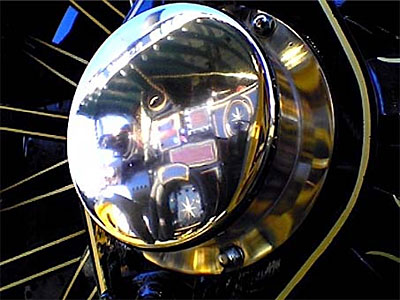
[more]
oil
Ideas about the Future of Energy in the US (from our Industry Insider and Prof. Goose)
|
* My point since we started this project has been that "peak oil" changes the rules of the domestic and geopolitical games. There is no more immediate supply of cheap oil to call upon than what we already extract daily: refining more-sour crude, exploration and retrieval only becomes more and more costly from here on in, and ergo, behaviors and lives will have to change to adapt.
Because of our crippling dependence on petroleum (which will become more obvious each day that passes in the coming weeks), one terrorist attack, one malevolent world leader with oil, or, unfortunately one event like Katrina that disrupts "the Spice" (Frank Herbert's Dune reference) can bring a country, especially one that uses a quarter of the world's daily supply of oil, to its knees.
Don't get me wrong. Ceteris paribus, Katrina would have desperately hurt the US had it happened 10 years ago. However, in the era of peak oil (when there's just no wiggle room to find cheap supply to put into the system), the turmoil that Katrina hath wrought may hurt us in ways we haven't even fathomed yet because of the way our lifestyles will have to change in order to adjust to less available energy.
| |
[more]
label art
Cigar Label Art

[more]
thanks to J-Walk Blog
bush
Here is a Bush joke that James Luckett sent me.
The US Postal Service has created a stamp with a picture of President George W. Bush to honor his first term achievements. In daily use it has been shown that the stamp is not sticking to envelopes. This has enraged the President, who demanded a full investigation.
After a month of testing, a special presidential commission has made the following findings:
1) The stamp is in perfect order.
2) There is nothing wrong with the applied adhesive.
3) People are spitting on the wrong side
Bush's popularity seems to be waning. Or sinking like a rock.
Bush Index
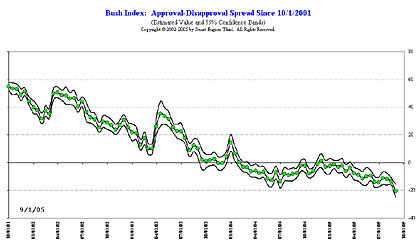
[more]
thanks to MyDD
It might do to check back on that chart since it is updated. Katrina just might accelerate that trend.
Bush's Obscene Tirades Rattle White House Aides
|
While President George W. Bush travels around the country in a last-ditch effort to sell his Iraq war, White House aides scramble frantically behind the scenes to hide the dark mood of an increasingly angry leader who unleashes obscenity-filled outbursts at anyone who dares disagree with him.
“I’m not meeting again with that goddamned bitch,” Bush screamed at aides who suggested he meet again with Cindy Sheehan, the war-protesting mother whose son died in Iraq. “She can go to hell as far as I’m concerned!”
Bush, administration aides confide, frequently explodes into tirades over those who protest the war, calling them “motherfucking traitors.” He reportedly was so upset over Veterans of Foreign Wars members who wore “bullshit protectors” over their ears during his speech to their annual convention that he told aides to “tell those VFW assholes that I’ll never speak to them again is they can’t keep their members under control.”
White House insiders say Bush is growing increasingly bitter over mounting opposition to his war in Iraq. Polls show a vast majority of Americans now believe the war was a mistake and most doubt the President’s honesty.
“Who gives a flying fuck what the polls say,” he screamed at a recent strategy meeting. “I’m the President and I’ll do whatever I goddamned please. They don’t know shit.”
| |
[more]
thanks to 'Just World News' by Helena Cobban
a tale of two shutters
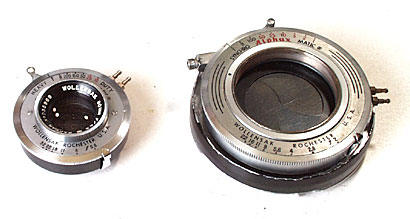
Here are two of my Alphax shutters. (I have a third one on my 10" Elgeet.) They're press type shutters. Most large format shutters have seperate cocking and firing levers. Press type shutters combine them. As you move the firing lever it cocks the the shutter and then fires in one motion. The downside is that higher shutter speeds require stiffer springs so they shutter usually have lower high shutter speeds. The little one goes to 1/200 sec. and the larger one to 1/100.
The little one is my "new" 90mm lens. It's a bit of a gamble. It's a Wollensak 90mm f4.5 Raptar. Most large format Wollensak 90mm lenses are f6.8 Raptars. There is a Wollensak 90mm f4.5 but it is an enlarger lens and is usually designated as an El Raptar. This lens doesn't have that designation. There is a C with a w inside it. I couldn't find anything on the internet about this lens. The previous owner couldn't either but we both don't think it's an enlarger lens. It's not too big of a gamble. F6.8 Raptars usually go for around $100. I paid $20 for this one. The previous owner checked the coverage on his Speed Graphic and it barely covered 4x5 which is normal for the f6.8 Raptars, too. It should cover more stopped down. I hope to check it out on Gordy's Image Circle Measuring Device® this weekend. If the Measuring Device works there will be pictures of it. I can't check it out on the Burke & James because it needs a recessed lensboard. The shutter works well at all speeds and the glass looks great. I have high hopes for this lens. It will also be used on my 3x4 Speed Graphic where it will have the equivalent coverage of a 30mm lens on a 35mm camera. And the press type shutter will make it easier to use. Could be fun. The rangefinder isn't cammed for 90mm but I can scale focus. I might even try to make a cam if it works out. When I get set up for 5x7 I will get a 90mm that covers that format for the Burke & James.
I kept looking at the little Alphax and realized what a nice shutter it would be for my pinhole. I even thought, only briefly, about using it for that but I want a 90mm on the Burke & James pretty bad. (It will be a 25mm equivalent.) Then I rememberd the secong Alphax shutter. It came with a bizarre 5" Elgeet on it (scroll down.) The 5" Elgeet barely covered 120 roll film. The larger Alphax is a larger shutter than I need for the pinhole but I already have it. The 1/5, 1/2, and 1 second settings don't work so well but all the other speeds are fine. It fits into the Mamiya lens mount. I need to attach it to the lens mount, mount a plate on the lip above the shutter leaves, and install the pinhole. Maybe a little black paint here and there. It will be a lot easier to make a pinhole hood if I need to. And the shutter is flash synched! A flash pinhole camera?
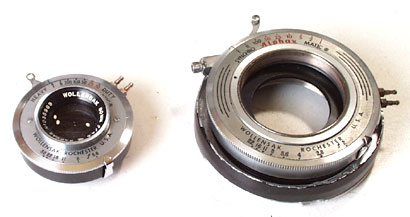
Here is the pinhole shutter with the shutter open. It has a T setting. Sweet!
katrina
How fucked up can this administration be? Did you know it's National Preparedness Month brought to you by Homeland Insecurity? It would be a joke if people weren't dead because of the incompetence of this administration. I've been following this disaster all day. I'm depressed and pissed. When are the people in this country going to throw these bufoons out?
Email attributed to NOLA rescue worker; economics of disaster
|
The poorest 20% (you can argue with the number -- 10%? 18%? no one knows) of the city was left behind to drown. This was the plan. Forget the sanctimonious bullshit about the bullheaded people who wouldn't leave. The evacuation plan was strictly laissez-faire. It depended on privately owned vehicles, and on having ready cash to fund an evacuation. The planners knew full well that the poor, who in new orleans are overwhelmingly black, wouldn't be able to get out. The resources -- meaning, the political will -- weren't there to get them out.
| |
[more]
Left Behind
|
The last twelve hours of news coverage has been nearly overwhelming. Anderson Cooper, Paula Zahn, others, even unapologetic partisans like Joe Scarborough and Tucker Carlson -- everyone is asking where the government is. (No, I haven't turned to Fox News. I don't have the heart, today.) Anderson Cooper lost it interviewing Sen. Mary Landrieu, countering her litany of thank-yous to a series of politicians with his own encounter with rats eating a body that had been left abandoned in the street for over 48 hours. Paula Zahn boggled at FEMA director Michael Brown's declaration that the reason about 15,000 shelter seekers at the New Orleans Convention Center have gone without food or water since the day of the hurricane is because FEMA didn't even know the refugees were there until today.
| |
[more]
The price of failure
by Steve Gilliard
|
George Bush has failed.
He has failed his office, he has failed the people of New Orleans, who he was elected to serve.
But most of all, he has failed the country.
This is not what Americans expect people to do in Bosnia. If Bosnians had been treated like the citizens of New Orleans, Americans would have been outraged. Wes Clark would have been retired in disgrace. It would have been a national disgrace. Americans would have been shamed to have failed the people of Bonsia so badly.
Yet the American bitter-enders, Goldberg, Limbaugh and Hannity, see no problem with Americans dying in the streets in an American city.
This is a national disgrace, a failure of imagination and leadership as bad as Bull Run. The weakness of Bush and his insanely incompetent leadership is murdering people as slowly and cruelly as the Serbs did. The anguish of the people is painful to watch.
| |
[more]
People should go to jail for this. There is no fucking excuse. Too many links to put up. Here are some sites that give good links:
Daily KOS
Eschaton
The News Blog (Steve Gilliard)
Culture of Life News
MSNBC
Read them and weep.
|
Thursday September 1 2005
|
donate
On the left of the page, under the navigation bar, there is a link "Liberal Blogosphere for Hurricane Relief". I donated. All of the proceeds will be sent to the Red Cross. Donations are being tracked by Drop Cash. Transactions are secured through Paypal. You can be certain that your contribution will be secure, for a good cause, and people will know it came from the liberal blogosphere. Please donate.
katrina
I had more links to put up but ran out of time. Life has been a little intense with Zoe's mom, who has Alzheimer's. Zoe talks about it here. And then there is Katrina and New Orleans. I was an Urban Planning major many years ago. (I quit that when I realized Urban Planning was an oxymoron.) I did learn about cities. Cities are more than buildings. Cities are the people that live there. People that form communities. People that have businesses selling groceries, changing tires, renting DVDs. Cities are very intricate webs of interactions. Cities are not just buildings. New Orleans has been destroyed. The buildings can be rebuilt but the communites are gone. New Orleans was a city of poor people. They aren't going to wait for months (years?) for their destroyed homes to be rebuilt, if they ever are. They will go elswhere. The New Orleans middle class is now poor. They are destitute. They have no homes and no jobs. They are all refugees. There is the short term tragedy of making it out of New Orleans alive. That will only be the beginning. There will be the mid term tragedy of what to do with hundreds of thousands of people without food, water, and housing. Then the ripples will move throughout this country. The economy is on a knife edge. Katrina may be a tipping point. I bought gas today. Premium is over $3 here on Whidbey Island. (That didn't take long.) This is a disaster greater than any I have seen in my lifetime and my kids will tell you that I'm older than dirt. And we will be seeing, in the weeks and months to come, what a bunch of worthless fuckheads we have in Washington. When two airliners crashed into two buildings almost four years ago I felt that it was much worse than it appeared at the time. No shit! Look what has happened to this country since. I think what is happening in New Orleans, as horrific as it may look, is going to be much worse than it appears.
When the Levee Breaks
by Billmon
|
Some media reports paint an picture of almost biblical desolation -- of pillars of smoke rising from fires that can't be as fought because there's no pressure in the water mains; of the risk that corpses from the city's vast above-ground cemeteries might be exhumed by the floodwaters and sent drifting through streets transformed into canals; of snakes, alligators and a three-foot shark -- yes, a shark -- spotted swimming in the fetid water.
Add in the raw waste from a hundred backed-up sewer lines, the rotting food from a hundred thousand kitchen refrigerators and the industrial filth of one of the country's largest ports and petrochemical centers, plus the corpses, dead animals, debris and the mosquito eggs -- many of them no doubt already hatching -- and you've got the makings of a first-class public health nightmare. Stew in the sun and the heat of a Louisiana September for a week or two, and watch the nightmare become a reality.
As a living, functioning city, then, New Orleans has ceased to exist. Even if it can eventually be resuscitated, the patient's long-term prognosis is grim. Just as yesterday was a catastrophe in slow motion, the future of the Crescent City is likely to be a slow, lingering death by drowning: the environmental equivalent of pulmonary edema. In that sense, New Orleans is the canary -- peacock might be the more appropriate bird -- in the mine of global climate change. If melting ice caps continue to push sea levels rapidly higher, its death may also await many of the world's other low-lying cities.
| |
[more]
"No one can say they didn't see it coming"
In 2001, FEMA warned that a hurricane striking New Orleans was one of the three most likely disasters in the U.S. But the Bush administration cut New Orleans flood control funding by 44 percent to pay for the Iraq war.
|
Biblical in its uncontrolled rage and scope, Hurricane Katrina has left millions of Americans to scavenge for food and shelter and hundreds to thousands reportedly dead. With its main levee broken, the evacuated city of New Orleans has become part of the Gulf of Mexico. But the damage wrought by the hurricane may not entirely be the result of an act of nature.
A year ago the U.S. Army Corps of Engineers proposed to study how New Orleans could be protected from a catastrophic hurricane, but the Bush administration ordered that the research not be undertaken. After a flood killed six people in 1995, Congress created the Southeast Louisiana Urban Flood Control Project, in which the Corps of Engineers strengthened and renovated levees and pumping stations. In early 2001, the Federal Emergency Management Agency issued a report stating that a hurricane striking New Orleans was one of the three most likely disasters in the U.S., including a terrorist attack on New York City. But by 2003 the federal funding for the flood control project essentially dried up as it was drained into the Iraq war. In 2004, the Bush administration cut funding requested by the New Orleans district of the U.S. Army Corps of Engineers for holding back the waters of Lake Pontchartrain by more than 80 percent. Additional cuts at the beginning of this year (for a total reduction in funding of 44.2 percent since 2001) forced the New Orleans district of the Corps to impose a hiring freeze. The Senate had debated adding funds for fixing New Orleans' levees, but it was too late.
| |
[more]
The Price of Poverty
by Steve Gilliard
|
New Orleans, despite it's tourist friendly image, has always lived on the edge, of poverty, of a great flood. So when things collapse, there is no surprise that the city collapses into disorder.
Many, many New Orleans residents barely had the resources to survive day to day living. When government checks come on the first week of the month, and even those with jobs may not have access to savings or even a bank account, cashing their checks at check cashing places, the ability to leave in a hurry is nearly impossible.
And when people talk about looting, there is a situation where there is no order, no supply, no water and no light. Also, people are being told to not walk around barefoot to avoid skin infections. Jungle rot and trench foot are all too common in damp situations. That means people can't walk.
The problem is that the government is treating this like a US domestic crisis where people can drive to relief centers and that ain't it.
| |
[more]
A political hurricane is gathering force
A war and a deluge stretch resources -- and nerves -- thin
|
For years the Pentagon’s standing readiness plans required the country to be able to fight two major wars simultaneously. But no one anticipated what we face now: a war in Mesopotamia and another along the Mississippi.
We have journalist Malcolm Gladwell to thank for the idea that every social phenomenon has a dramatic “tipping point.” It doesn’t always work that way. And yet Hurricane Katrina is just such a moment. We are a big, strong country — and New Orleans will, somehow, survive — but you do get the sense, as President Bush finally arrived here after a month-long vacation, that a political hurricane is gathering force, and it’s going to hit the capital any day.
| |
[more]
thanks to Steve Gilliard's News Blog
Where's Bush?
by Steve Gilliard
Steve Gillard quotes the above piece and adds...
|
The problem is that, no New Orleans, may not survive, not in the way we're used to seeing the city. But the problem is going to be a military one, complete with refugee camps and massive government funding. Churches and the Astrodome can only last for so long. They can't put people up for six months or more and that's what we're facing here. We don't know if another hurricane is coming or not. Florida had four last year.
All of Bush's pro-greed policies are going to face reality. New Orleans is a poor ,black city and the people there will need massive government help in a way WTC workers and their families didn't. The aid is trickling in and we're watching people die on TV.
| |
[more]
A failure of leadership
by Steve Gilliard
|
If Bush understood how serious this was, a brigade of the 101st would be have moved to Ft. Polk over the weekend and their helicopters would have been rescuing people as soon as the weathered cleared. Their heavy lift battalion would have been ferrying in supplies to isolated communities and the AF would have been dropping humanitarian aid packages like they did in Afghanistan over isolated rural areas. But that would be a serious understanding of the situation. Like taking over a couple of military bases recently closed and starting to build housing there and establishing order. The Astrodome will turn into the Superdome within days.
The response here has not met the need in any way, shape or form. Just three C-130's could have tossed out enough food and water to keep people alive until the trucks arrived in the rural areas.
Instead, this is disaster business as usual and that is condemning people to die.
| |
[more]
'And Now We Are in Hell'
Inside the Superdome
|
There are four levels of hell inside the refugee city of the Superdome, home to about 15,000 people since Sunday. On the artificial-turf field and in the lower-level seats where Montrel sat sweltering with her family, a form of civilization had taken hold -- smelly, messy, dark and dank, but with a structure. Families with cots used their beds as boundaries for personal space and kept their areas orderly, a cooler on one corner, the toys on another, almost as if they had come for fireworks and stayed too long.
The bathrooms, clogged and overflowing since Monday, announced the second level of hell, the walkway ringing the entrance level. In the men's, the urinal troughs were overflowing. In the women's, the bowls were to the brim. A slime of excrement and urine made the walkway slick. "You don't even go there anymore," said Dee Ford, 37, who was pushed in a wading pool from her flooded house to the shelter. "You just go somewhere in a corner where you can. In the dark, you are going to step in poo anyway."
Water and electricity both failed Monday, and three pumps to pressurize plumbing have been no match "when the lake just keeps pushing it back at us," said Maj. Ed Bush, the chief public affairs officer for the Louisiana National Guard.
"With no hand-washing, and all the excrement," said Sgt. Debra Williams, who was staffing the infirmary in the adjacent sports arena, "you have about four days until dysentery sets in. And it's been four days today."
[...]
"This is mass chaos," said Sgt. Jason Defess, 27, a National Guard military policeman who had been stationed on a ramp outside the Superdome since Monday. "To tell you the truth, I'd rather be in Iraq," where he was deployed for 14 months, until January. "You got your constant danger, but I had something to protect myself. [And] three meals a day. Communications. A plan. Here, they had no plan."
| |
[more]
City of Nature
New Orleans' blessing; New Orleans' curse.
|
In retrospect, the idea was so stupid and yet so American: Move the homeless, the elderly, the impoverished, the unlucky, all those poor souls who couldn't get out of New Orleans in time to avoid Hurricane Katrina; move them into the city's cavernous domed football stadium. Anyone who has seen a disaster movie could have predicted what would happen next: Katrina slammed into the Superdome, ripped off the roof, and knocked out the power, cutting off the drinking water and the air conditioning. Those trapped inside had to be moved again—to Houston's Astrodome, of course.
If it's not too callous to say so while the tragedy on the Gulf Coast is still unfolding, the stadium mishap is an apt metaphor for New Orleans' environmental history. The sodden city has long placed itself in harm's way, relying on uncertain artifice to protect it from unpredictable environs.
| |
[more]
thanks to Talking Points Memo
book recommendation
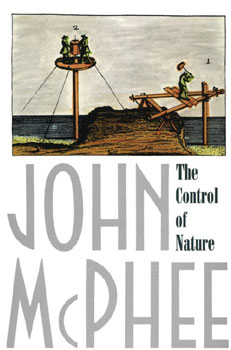
It's been a while since I've read this book but recent events make it most timely. John McPhee is probably my favorite writer, certainly my favorite non-fiction writer. This book covers three different cases of man trying to control nature. New Orleans and it's systems of levees and pumps is one of the cases. A must read. Salon has an excerpt linked below to give you a taste.
The battle of New Orleans
Long before Hurricane Katrina, New Orleans was in a precarious state -- caught in an ongoing war with the mighty Mississippi River.
|
Something like half of New Orleans is now below sea level -- as much as fifteen feet. New Orleans, surrounded by levees, is emplaced between Lake Pontchartrain and the Mississippi like a broad shallow bowl. Nowhere is New Orleans higher than the river's natural bank. Underprivileged people live in the lower elevations, and always have. The rich -- by the river -- occupy the highest ground. In New Orleans, income and elevation can be correlated on a literally sliding scale: the Garden District on the highest level, Stanley Kowalski in the swamp. The Garden District and its environs are locally known as uptown.
Torrential rains fall on New Orleans -- enough to cause flash floods inside the municipal walls. The water has nowhere to go. Left on its own, it would form a lake, rising inexorably from one level of the economy to the next. So it has to be pumped out. Every drop of rain that falls on New Orleans evaporates or is pumped out. Its removal lowers the water table and accelerates the city's subsidence. Where marshes have been drained to create tracts for new housing, ground will shrink, too. People buy landfill to keep up with the Joneses. In the words of Bob Fairless, of the New Orleans District engineers, "It's almost an annual spring ritual to get a load of dirt and fill in the low spots on your lawn." A child jumping up and down on such a lawn can cause the earth to move under another child, on the far side of the lawn.
Many houses are built on slabs that firmly rest on pilings. As the turf around a house gradually subsides, the slab seems to rise. Where the driveway was once flush with the foor of the carport, a bump appears. The front walk sags like a hammock. The sidewalk sags. The bump up to the carport, growing, becomes high enough to knock the front wheels out of alignment. Sakrete appears, like putty beside a windowpane, to ease the bump. The property sinks another foot. The house stays where it is, on its slab and pilings. A ramp is built to get the car into the carport. The ramp rises three feet. But the yard, before long, has subsided four. The carport becomes a porch, with hanging plants and steep wooden steps. A carport that is not firmly anchored may dangle from the side of a house like a third of a drop-leaf table. Under the house, daylight appears. You can see under the slab and out the other side. More landfill or more concrete is packed around the edges to hide the ugly scene. A gas main, broken by the settling earth, leaks below the slab. The sealed cavity fills with gas. The house blows sky high.
| |
[more]
oil
Newest (and very informative and very scary) report from an anonymous insider
|
There are MANY production platforms missing (as in not visible from the air). This means they have been totally lost. I am talking about 10's of platforms, not single digit numbers. Each platform can have from 4 to 100+ wells on it. Most larger ones have 20-30 wells in this area, with numerous caisson wells. They are on their sides, on the bottom of the gulf - they will likely be left as reef material, provided we can get permission. MMS regulations require us to plug each of the wells that were on these platforms - HUGE cost now, as the platforms are gone... Hopefully, MMS will grant `abandon in place' status for these wiped out structures.
We also set individual wells as satellites and pipe them back to existing platforms. These stand-alone wells are called caisson wells. 90% of those in the storm path are bent over, rendering them a total loss, We would have to remove the existing bent structure and drill a new well, as bent pipe is basically unusable.
We utilize platforms as gathering hubs. We pipe the raw oil/water to them and then send it on for separation, or separate it there and send finished oil on. Damage to a hub means everything going to the hub is offline indefinitely. There are +/- 15 HUBS missing. MISSING!! As in we cannot find them from the air.
Thus even if the wells feeding the hub are ok, we have nowhere to pump the oil to...
| |
[more]
AN OIL PANIC IN PLAIN SIGHT
|
- Hurricane Katrina smashes "Energy Alley," a concentrated area of oil production in Gulf of Mexico that supplies about 35% of America's domestic oil.
- White House says oil will get cheaper, but makes hush-hush plans to increase the Strategic Petroleum Reserve by 42% to ONE BILLION barrels of crude. Why are they so eager to add to the SPR when oil prices are high?
- Saudis reveal they won't be able to meet oil demand – first time EVER they've admitted the awful truth
Hurricane Katrina delivered a devastating blow to America even before it slammed into Louisiana. The Massive storm smashed through "Energy Alley," a concentrated area of oil rigs off the coast that supply about 35% of America's domestic oil production and 20% of its natural gas. It damaged much of our nation's oil production.
At the same time, workers rushed to shut down the offshore Louisiana Offshore Oil Port, which processes loads from tankers too large for mainland ports. The LOOP is the nation's largest oil import terminal, handling 11% of U.S. imports. And refiners shut down more than a million barrels a day of production as they braced for the impact from the monster storm. Those refineries will probably be out for at least two weeks, setting the stage for a potential gasoline shortage.
Panicked oil traders are pushing oil prices over $70 per barrel. And now for the really scary part. A devastating hurricane strike at America's oil and gas operations in the Gulf of Mexico is just one of the major forces that could send oil to $80 ... $100 ... $150 a barrel. Other forces that could send oil prices surging are potentially much more serious...and permanent!
The Saudis are the "central bank of oil," right? So how come the central bank is scrounging for loose change under the couch cushions?
| |
[more]
thanks to The Oil Drum
Hurricane + Guest Column
by James Kunstler
|
Waiting for Hurricane Katrina to land on New Orleans this morning, the news reports are ominous. But the photo above (posted on Internet news services) says a lot to me about the current condition of the American people. While we know many of those who sought shelter in the New Orleans Superdome are poor and without means of escape, they end up trapped in the high priced seats passively awaiting a spectacle that may destroy their way of life. Fate becomes just another spectator sport.
It seems possible to me that we will be seeing gas station lines all over America within the week.
| |
[more]
little trees
Bonsai: Worlds Within Worlds
|
Bonsai at its highest level is a fine art. But fine art begins with great craft. Westerners aspiring toward bonsai art excellence would do well to follow the craftsmanship found in excellent bonsai examples.
| |

[more]
thanks to reading & writing
iraq
The Vietnamization of Bush's Vacation
by Frank Rich
|
ANOTHER week in Iraq, another light at the end of the tunnel. On Monday President Bush saluted the Iraqis for "completing work on a democratic constitution" even as the process was breaking down yet again. But was anyone even listening to his latest premature celebration?
We have long since lost count of all the historic turning points and fast-evaporating victories hyped by this president. The toppling of Saddam's statue, "Mission Accomplished," the transfer of sovereignty and the purple fingers all blur into a hallucinatory loop of delusion. One such red-letter day, some may dimly recall, was the adoption of the previous, interim constitution in March 2004, also proclaimed a "historic milestone" by Mr. Bush. Within a month after that fabulous victory, the insurgency boiled over into the war we have today, taking, among many others, the life of Casey Sheehan.
| |
[more]
camera art
This is one of the most amazing camera building projects I've seen.
The Vertical Banquet Camera Project
|
My wife Susan has been experimenting with both 4x10 and 8x20 Banquet Cameras. She has done some really nice work using these cameras and was wanting to expand the creative possibilities by shooting the cameras in the vertical orientation. She first explored this elongated vertical format by rotating her 4x10 field camera on its tripod head. Not exactly easy to operate the camera in this position, but it did prove to be an interesting format that she wanted to further explore.
| |

[more]
thanks to The Analog Photography Users Group
economy
Economic Stormy Weather Ahead
|
Alan Greenspan believes that housing boom has reached its peak and that housing prices will start to decline. So what does that mean? Well, to get full appreciation of what it means, you should have been watching the most recent NOW program on the housing pyramid scheme. David Brancaccio looked into the housing market in Santa Rosa, CA, where the hot California market has driven housing prices to unbelievable prices. One of the factors driving California housing prices is the array of mortgage vehicles, including the incredibly risky interest-only loan. Even back in 2002, Californians seeking to get into the housing market were flocking to the interest-only loans. Today, nearly half of the market for new mortgages in California are interest-only loans.
| |
[more]
stamps
American Science, RIP

[more]
thanks to J-Walk Blog
health care
THE MORAL-HAZARD MYTH
The bad idea behind our failed health-care system.
|
The U. S. health-care system, according to “Uninsured in America,” has created a group of people who increasingly look different from others and suffer in ways that others do not. The leading cause of personal bankruptcy in the United States is unpaid medical bills. Half of the uninsured owe money to hospitals, and a third are being pursued by collection agencies. Children without health insurance are less likely to receive medical attention for serious injuries, for recurrent ear infections, or for asthma. Lung-cancer patients without insurance are less likely to receive surgery, chemotherapy, or radiation treatment. Heart-attack victims without health insurance are less likely to receive angioplasty. People with pneumonia who don’t have health insurance are less likely to receive X rays or consultations. The death rate in any given year for someone without health insurance is twenty-five per cent higher than for someone with insur-ance. Because the uninsured are sicker than the rest of us, they can’t get better jobs, and because they can’t get better jobs they can’t afford health insurance, and because they can’t afford health insurance they get even sicker. John, the manager of a bar in Idaho, tells Sered and Fernandopulle that as a result of various workplace injuries over the years he takes eight ibuprofen, waits two hours, then takes eight more—and tries to cadge as much prescription pain medication as he can from friends. “There are times when I should’ve gone to the doctor, but I couldn’t afford to go because I don’t have insurance,” he says. “Like when my back messed up, I should’ve gone. If I had insurance, I would’ve went, because I know I could get treatment, but when you can’t afford it you don’t go. Because the harder the hole you get into in terms of bills, then you’ll never get out. So you just say, ‘I can deal with the pain.’ ”
| |
[more]
thanks to Bad Attitudes
trees
The Wollemi Pine
|
The Wollemi Pine is one of the world's oldest and rarest plants dating back to the time of the dinosaurs. With less than 100 adult trees known to exist in the wild, the Wollemi Pine is now the focus of extensive research to safeguard its survival. By 2005/6 you will be able to assist in the conservation effort by growing your own Wollemi Pine and becoming part of one of the most dramatic comebacks in natural history.
| |

[more]
thanks to Coudal Partners
book recommendation

I've had this book for a number of years. It was published in 1986 and I think I got it from Daedalus Books. Daedalus Books handles remaindered books and they put out a thick newsprint catalog that was very dangerous. Now they are online. I'm in danger again. Anyway, I was emptying some boxes and it jumped into my hand. I had started it years ago but didn't finish it. It's funny how sometimes you aren't ready for a book and other times you are. I was ready this time.
Marguerite Duras was a French novelist and screenplay witer (Hiroshima, Mon Amour.) This is a memoir of her experiences at the end of WWII. (She was part of the French resistance under Françoise Mitterand.) Her stories capture the uncertainty of life as the war ends and the people return from the front and from the concentration camps. The time in between war and not war. The time of displaced people. The time as one order ends but the new order hasn't quite begun.
Marguerite Duras (1914-1996)
Marguerite Duras
|
|
|
|















